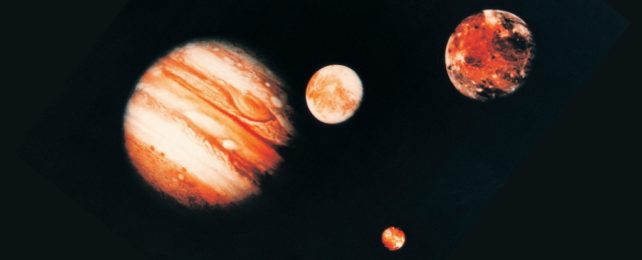Jupiter is well known for its spectacular aurorae, thanks in no small part to the Juno orbiter and recent images taken by the James Webb Space Telescope (JWST). Like Earth, these dazzling displays result from charged solar particles interacting with Jupiter's magnetic field and atmosphere.
Over the years, astronomers have also detected faint aurorae in the atmospheres of Jupiter's largest moons (aka. the "Galilean Moons"). These are also the result of interaction, in this case, between Jupiter's magnetic field and particles emanating from the moons' atmospheres.
Detecting these faint aurorae has always been a challenge because of sunlight reflected from the moons' surfaces completely washes out their light signatures. In a series of recent papers, a team led by the University of Boston and Caltech (with support from NASA) observed the Galilean Moons as they passed into Jupiter's shadow.
These observations revealed that Io, Europa, Ganymede, and Callisto all experience oxygen-aurorae in their atmospheres. Moreover, these aurorae are deep red and almost 15 times brighter than the familiar green patterns we see on Earth.
The research team included astronomers from the Center for Space Physics (CSP) at Boston University, the Division of Geological and Planetary Sciences (GPS) at Caltech, the Laboratory for Atmospheric and Space Physics (LASP) at the University of Colorado, Earth and Planetary Science at the UC Berkeley, Large Binocular Telescope Observatory (LBT), the Southwest Research Institute (SwRI), the Planetary Science Institute (PSI), the Leibniz-Institute for Astrophysics Potsdam (AIP), and NASA's Goddard Space Flight Center.
The two studies, titled "The Optical Aurorae of Europa, Ganymede, and Callisto" and "Io's Optical Aurorae in Jupiter's Shadow," appeared on February 16th in the Planetary Science Journal.
The team's observations combined data from the Keck Observatory's High-Resolution Echelle Spectrometer (HIRES) with high-resolution spectra from the Large Binocular Telescope (LBT) and the Apache Point Observatory (APO).
These observations were timed to see Io, Europa, Ganymede, and Callisto when they entered Jupiter's shadow to avoid interference from sunlight reflected off their surfaces. This data revealed valuable information concerning the composition of the moons' atmospheres, which included oxygen gas (as expected).
Katherine de Kleer, a Caltech professor and the lead author of one of two papers, explained in a Keck Observatory press release:
"These observations are tricky because in Jupiter's shadow the moons are nearly invisible. The light emitted by their faint aurorae is the only confirmation that we've even pointed the telescope at the right place. The brightness of the different colors of aurora tell us what these moons' atmospheres are likely made up of. We find that molecular oxygen, just like what we breathe here on Earth, is likely the main constituent of the icy moon atmospheres."
All four Galilean Moons showed the same oxygen aurorae, similar to what we see with the Aurora Borealis and Australis (the Northern and Southern Lights) here on Earth.
In the case of Europa, Ganymede, and Callisto, the oxygen content of their atmospheres is due to photolysis, a process where water ice sublimates and is broken down by solar radiation into its hydrogen gas and oxygen. In Io's case, the oxygen is caused by sulfur dioxide (spewed from the many volcanoes that dot its surface) interacting with solar radiation to form sulfur monoxide and elemental oxygen.
But because of their much thinner atmospheres, this oxygen glows in the deep red and (for Europa and Ganymede) in infrared wavelengths – the latter being undetectable to the human eye.
Because of Io's volcanic activity, salts like sodium chloride and potassium chloride are also present in the atmosphere, where they are also broken down by solar radiation. This leads to aurorae on Io emitting a yellow-orange glow (caused by sodium) and glowing in the infrared (caused by potassium).
This was the first time astronomers observed this infrared glow in these moons' atmospheres. What's more, the new measurements also revealed minimal evidence of water vapor, which was previously thought to be a component in the atmospheres of Europa, Ganymede, and Callisto.
All three moons are theorized to have interior oceans beneath their icy surfaces, and there's even some tentative evidence that water vapor in Europa's atmosphere may result from plume activity. These plumes are thought to be connected to the moon's interior ocean or liquid reservoirs within its icy shell.
The observations also showed how Jupiter's tilted magnetic field causes aurorae to vary in brightness as the gas giant rotates. The tilt of this field, roughly 10° from Jupiter's axis of rotation compared to Earth's 11° tilt, means that the moons will experience greater interaction at certain times of their orbit.
Lastly, they also noted how the atmospheres responded rapidly to temperature changes caused by the transition between exposure to sunlight and passing within Jupiter's shadow. Said Carl Schmidt, a professor of astronomy at Boston University and the lead author of the second paper:
"Io's sodium becomes very faint within 15 minutes of entering Jupiter's shadow, but it takes several hours to recover after it emerges into sunlight. These new characteristics are really insightful for understanding Io's atmospheric chemistry. It's neat that eclipses by Jupiter offer a natural experiment to learn how sunlight affects its atmosphere."
These latest observations have added excitement to what is already a very exciting field of research. In the coming years, space agencies will send more robotic explorers to Europa and Ganymede – NASA's Europa Clipper and the ESA's JUpiter ICy moon Explorer (JUICE).
These missions will conduct multiple flybys of these moons, gather data on the compositions of their atmospheres and surfaces, and attempt to spot indications of possible life in their interiors ("biosignatures"). Seeing these bright red aurorae up close will be nothing short of jaw-dropping!
This article was originally published by Universe Today. Read the original article.
